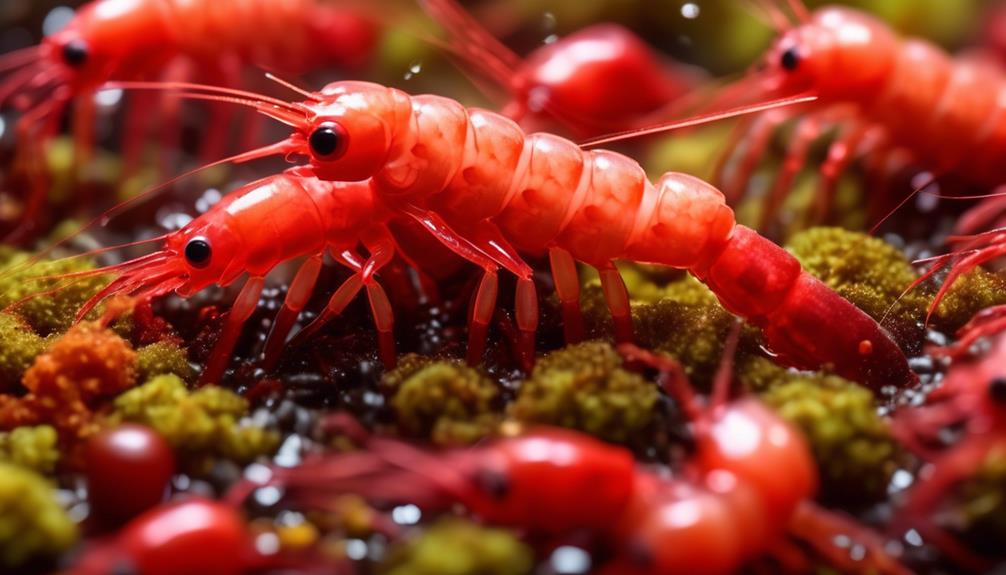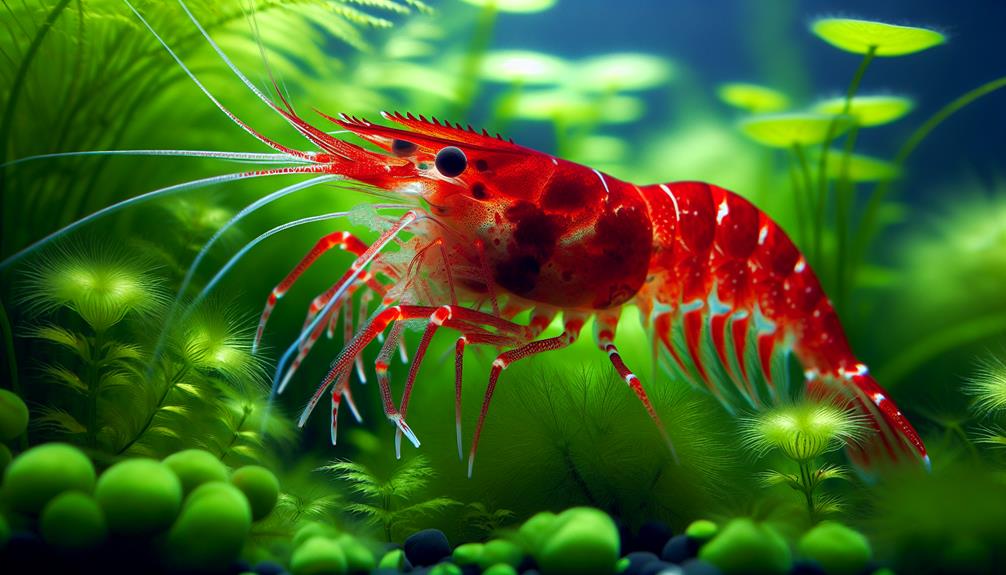Breeding vibrant Red Cherry Shrimp requires a deep understanding of their unique characteristics and specific care requirements. From creating the optimal environment for spawning to enhancing their brilliant hues, there are secrets to uncover in successfully raising these captivating creatures.
But what are these secrets, and how can they be applied to ensure the health and vibrancy of your shrimp? In this article, we will explore the ideal water conditions for breeding, methods to enhance coloration, tips for creating the perfect spawning environment, strategies for nurturing and protecting newborn shrimp, and feeding techniques for healthy growth.
By delving into these intricacies, you will gain valuable insights that will undoubtedly bring you one step closer to becoming a successful Red Cherry Shrimp breeder.
Key Takeaways
- Red Cherry Shrimp thrive in clean water with a pH of 6.5-8.0 and a temperature range of 14-30 degrees C.
- The color intensity of Red Cherry Shrimp is influenced by factors such as food, water pH, temperature, and the substrate color in the tank.
- Females are the most colorful and sensitive to substrate and background colors, and they have a yellowish saddle on their back when carrying eggs.
- To successfully breed Red Cherry Shrimp, it is important to maintain stable water conditions, provide a regular food source, and create a predator-free environment with hiding places for baby shrimp.
Ideal Water Conditions for Breeding
To successfully breed Red Cherry Shrimp, it is crucial to create and maintain ideal water conditions. This includes maintaining pH levels and temperature control.
Red Cherry Shrimp thrive in clean water with a pH range of 6.5-8.0. It is important to regularly test and adjust the pH levels to ensure optimal conditions for breeding.
Temperature control is equally important, with Red Cherry Shrimp preferring a temperature range of 14-30 degrees Celsius (57-86 degrees Fahrenheit). Fluctuations in temperature can stress the shrimp and hinder their breeding process.
It is recommended to use a reliable aquarium heater and thermometer to maintain a consistent temperature. By carefully monitoring and adjusting the pH levels and temperature, breeders can create the ideal water conditions necessary for successful Red Cherry Shrimp breeding.
Enhancing Coloration for Vibrant Shrimp
Enhancing the coloration of Red Cherry Shrimp can be achieved through careful manipulation of their environment and diet. Two key factors that greatly influence their color intensity are substrate selection and temperature.
The choice of substrate can have a significant impact on the vibrancy of the shrimp's coloration. Light-colored substrates tend to make the shrimp appear paler, while darker substrates enhance their coloration. By selecting a substrate that complements the shrimp's red hue, their natural coloration can be intensified.
Temperature also plays a crucial role in determining the color intensity of Red Cherry Shrimp. Optimal temperature ranges between 20-25 degrees Celsius (68-77 degrees Fahrenheit) can promote vibrant coloration. Temperatures outside of this range may result in less intense colors.
To further enhance the coloration of Red Cherry Shrimp, it is essential to provide a balanced diet rich in nutrients. Foods such as high-quality shrimp pellets, algae wafers, and blanched vegetables can contribute to their vibrant appearance.
By carefully considering substrate selection and maintaining appropriate temperature ranges, aquarists can greatly enhance the coloration of Red Cherry Shrimp, creating a visually striking and vibrant display.
| Factor | Effect on Shrimp Color Intensity |
|---|---|
| Substrate Selection | Light-colored substrates make shrimp appear paler; Darker substrates enhance coloration |
| Temperature | Optimal temperature range of 20-25°C (68-77°F) promotes vibrant coloration |
Creating the Perfect Environment for Spawning

The successful breeding of Red Cherry Shrimp relies on creating an optimal environment that caters to their specific spawning requirements. To enhance coloration and promote successful spawning, selective breeding techniques can be implemented.
When setting up a breeding tank, certain conditions must be met. Maintaining a clean water environment with a pH range of 6.5-8.0 and a temperature range of 14-30 degrees C (57-86 degrees F) is crucial. The tank should also include live moss and shrimp caves, providing hiding places for the shrimp during spawning and for the baby shrimp to find food and shelter.
It is essential to ensure that there are no predators in the tank that could harm the newborn shrimp.
Nurturing and Protecting Newborn Shrimp
After the successful spawning of Red Cherry Shrimp, it is crucial to provide proper care and protection for the newborn shrimp. Ensuring shrimp survival requires specific shrimp breeding techniques and attention to detail. Here are five important steps to nurture and protect newborn shrimp:
- Maintain stable water conditions: Keep the water parameters consistent, including temperature, pH, and ammonia levels. Sudden changes can stress the shrimp and affect their survival.
- Provide a safe environment: Create hiding places using live moss and shrimp caves to protect the baby shrimp from potential predators. These hiding spots also provide a source of food for the shrimp.
- Offer appropriate food: Newborn shrimp require a diet of infusoria, microorganisms, and powdered shrimp food. Ensure the food is small enough for them to consume easily.
- Monitor water quality: Regularly test the water for ammonia, nitrate, and nitrite levels. High levels of these compounds can be harmful to the shrimp.
- Perform regular water changes: Change a portion of the water regularly to maintain optimal water quality. This helps remove any accumulated waste or toxins.
Feeding Strategies for Healthy Shrimp Growth

To ensure the healthy growth of Red Cherry Shrimp, implementing effective feeding strategies is crucial. These strategies should take into account the feeding frequency and optimal water temperature for the shrimp.
Red Cherry Shrimp thrive in a temperature range of 14-30 degrees Celsius (57-86 degrees Fahrenheit), so maintaining the water temperature within this range is essential for their growth and overall well-being.
As for feeding frequency, it is recommended to feed the shrimp small amounts of food multiple times a day. This approach prevents overfeeding and ensures that the shrimp have a constant supply of nutrients. Overfeeding can lead to water pollution and negatively impact the shrimp's health.
Therefore, it is important to monitor the shrimp's feeding habits and adjust the feeding frequency accordingly. By implementing these feeding strategies, shrimp owners can contribute to the healthy growth of their Red Cherry Shrimp.
Frequently Asked Questions
How Long Does It Take for Red Cherry Shrimp to Start Breeding?
Red Cherry Shrimp typically start breeding after 3-5 months, with females being most receptive just after molting. Optimal breeding conditions include stable water conditions, regular food sources, and the provision of live moss and shrimp caves for the newborn shrimp.
What Are Some Indicators That a Female Shrimp Is Ready to Breed?
Female shrimp that are ready to breed exhibit certain behaviors and physical characteristics. These indicators include a yellowish saddle on their back, which signifies developing eggs, and increased receptiveness just after molting. Ideal breeding conditions involve stable water conditions and the presence of live moss and shrimp caves for the protection and nourishment of the baby shrimp.
How Long Do Female Shrimp Carry Their Eggs Before They Hatch?
Female shrimp carry their eggs for approximately 30 days before they hatch, during which they diligently fan and move the eggs for oxygenation. It is crucial to provide a predator-free tank, live moss, and shrimp caves for the newborn shrimp to hide and find food.
What Are Some Potential Predators That Could Harm Newborn Shrimp?
Predator identification is crucial for preventing attacks on newborn Red Cherry Shrimp. Potential predators include fish, larger shrimp, and snails. Implementing a well-planned tank setup, with hiding places and adequate food sources, can help safeguard the vulnerable shrimp.
How Often Should Uneaten Food Be Removed From the Tank to Maintain Water Quality?
Uneaten food should be removed from the tank every 2-3 hours to maintain water quality and ensure breeding success. Regular removal of uneaten food prevents water pollution and maintains optimal conditions for the vibrant red cherry shrimp.
Conclusion
In conclusion, the secrets of breeding vibrant Red Cherry Shrimp have been unveiled, providing essential information and techniques for successful maintenance and reproduction of these captivating aquatic creatures.
By understanding their preferred water conditions, temperature range, and lifespan, as well as the impact of factors such as food, water pH, temperature, and substrate coloration on their vibrant hues, enthusiasts can create the perfect environment for breeding and nurturing these shrimp.
By applying the knowledge gained from this article, one can embark on a rewarding journey of breeding and caring for these beautiful creatures.

